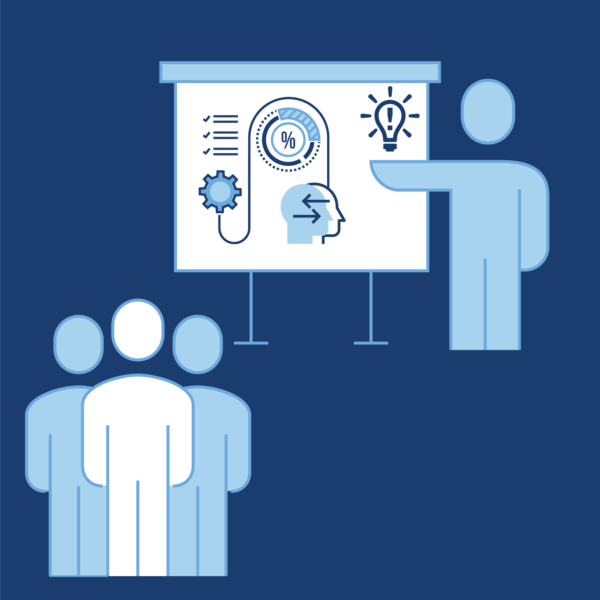Why EDUCATE?

Teach groups in a way that inspires action.
Participants will learn new insights and have the possibility to apply, innovate, and take coordinated action.
EDUCATE meetings differ from training sessions. Training conveys a single method or way of doing, whereas EDUCATE meetings generate novel possibilities.
- EDUCATE meetings are distinct from INFORM meetings in that sessions are designed to inspire action, not just awareness.
- Invite stakeholders with divergent perspectives to ensure shared and coordinated action. This is essential to implement a leader's ideas and vision with organizational cohesion.
- Plan ahead for participants to set the pace of the meeting. Participants may want to speed up rudimentary information and quickly introduce specific challenges related to the topic. Adults benefit from self-directed learning environments.
- Avoid creating fragmentation in culture by engaging all participants, particularly those with divergent points of view about the ideas you’re teaching.
- Not all participants need to take the same action leaving an EDUCATE meeting. Allow participants to imagine what inspired actions are of highest value and encourage them to experiment with possibilities.
- Don’t forget that participants learn differently, so infuse multiple learning modalities in your meeting.

Distinguish Learner vs. Judger

Frame EDUCATE meetings from a Learner mindset to activate the curiosity of participants and draw them in to learn more.
Leading a meeting from a Learner mindset invites participants to consider: What’s possible, and where can we go?
Leading a meeting from a Judger mindset drives participants to focus on: What’s wrong and needs to be fixed?
Before the meeting draft a possibility statement, 1-2 sentences, (“I see the possibility of _____ as a result of this meeting”) you envision for the world, the organization, or the participants. You will get your point across simply and succinctly.
Craft your possibility statements from the “outside in.” With the new insights gained, what will your participants create
- for your customers or the world?
- for the organization?
- for themselves?
Have participants identify ways they can apply their daily activities to realizing the possibility statement.
- Be careful about referencing past examples or events that could mean different things to participants. Talk about the future and compare it to outside entities your group aspires to be.
- Stating what participants will not learn from the meeting is as important as what will be learned. For example, participants may get information on using new visual design software, but won’t be taught ancillary communications skills.
- Educating participants about what’s wrong can disempower them. Noting the facts of a current situation and discussing the possibilities invites participants into action.

Scope with S.T.A.R.

Determine the relevant parameters of the meeting to create a clear path to reach outcomes.
What’s the Situation?
What Tasks (skills) are we developing?
What Actions are we now empowered to take
…in order to achieve the Results we desire?
- Describe the Situation using data available to all. Focus on quantitative and qualitative evidence that supports your claims.
- Use specific scenarios to check progress and comprehension among participants. Have participants discuss their new, tailored course of action. Use sticky notes to capture actions and discuss for shared learning.
- Invite participants to infuse their life experiences and prior knowledge.
- Be strategic about the framing of the Situation. Use examples of current circumstances for powerful learning. Use role playing to give context and to encourage participants to view the Situation from different perspectives.
- Having a large EDUCATE meeting may constrain introverted participants. Broaden and deepen the interaction and voices in the room by inserting breakout discussions.
- What’s possible will quickly fade in the group’s mind if current conditions are stressful. Don’t hesitate to state, restate, and post the possibility statement before participants work through the S.T.A.R. method.

Capture Words and Pictures

Capture key concepts throughout the meeting including words and pictures for future reference.
Consider using a Learning Journal, the foundation of a leader’s tool kit where he/she keeps all of insights, observations, and key ah-has for easy access and quick reference.
- Prepare a simple Learning Journal and remind participants to note key takeaways. Invite them to share what they record for the good of the group. If appropriate, co-create a collective journal of takeaways.
- Consider using a graphic recorder to capture participants' learning journey and to represent key takeaways from the session. Allow time for a “gallery walk” for participants to review the graphic capture and discuss their shared experience.
- Avoid reading from a script to convey information. Instead, tell a story about the information displayed, and ask individuals to make connections by processing the information aloud. Sense-making (i.e. how individuals make sense of an event, incident, or situation) is most powerful when discussed as a group.
- Avoid placing too much information on a shared display or screen - participants will miss your point.
- Co-creating stories is critical to keeping participants engaged. Acknowledge the more vocal participants, but also draw out the quieter group members to ensure all perspectives are heard.

Recognize the Downstream Impact

Ask participants to think through the downstream impact, or the unintended consequences that potential actions may have on the organization or individuals.
Participants often tend to hone in on how an idea or action will free up or constrain only themselves.
- Ask participants to generate as many ideas about how to apply their new insights as possible and share the non-obvious with each other. This timed exercise helps apply the new insights and positively crystallizes the relevance of the meeting.
- Learn from counterpoints by dissecting ideas inspired from new insights. Ask each participant to pick one of their ideas, then adopt the perspective of someone else (in or outside the room), and complete the following statement: If we do___ then ____ may happen. To mitigate this, we might_____.
- At the conclusion of this section, remind participants they are entering a new reality based on the insights gained in the meeting. Ask them to try “failing forward” with you by continuing to learn and improve the organization rather than remaining in the current state.
- Avoid spending time on fear-based arguments. Acknowledge the point, but don’t spend more time than needed if solutions are not being offered.
- Avoid mixing up problems and difficulties when applying new insights. They are different but can show up as the same in a group setting; failing to distinguish one from the other can leave participants paralyzed. Problems can be solved by participants, while difficulties are outside their control and must be managed.
Use the “stake” conversation to propel and inspire a case for change. Ask:
- What are we protecting if we do not change?
- What opportunities will we miss if we keep things as they are?
- What good might we achieve if we embrace the new reality?
- What do we need to be successful in the new reality?

Acknowledge Big Hat vs. Little Hat

Acknowledge the multiple perspectives participants are carrying . The Big Hat looks out for the whole and the Little Hat looks out for the individual.
Both are valuable and necessary to move an organization forward but until both viewpoints are named, the conflict between them is pervasive and counterproductive.
Acknowledge the tension this creates for individuals. Explore how the group can address these tensions.
- Make the distinction that ideas can be prioritized differently when thinking about the impact on an individual rather than the group. Ask participants to prioritize their newly generated ideas into two categories: 1) What’s good for the individual? and 2) What’s good for the whole?
- Use a Venn diagram to organize and capture ideas. The first circle is labeled “Me” and the second circle is labeled “The Organization.” Capture and discuss newly generated possibilities in each appropriate section. This graphic allows you to acknowledge the individual and the whole.
- When acting collectively, ensure shared goals are visible and comprehensible to all participants.
- Avoid making the “Big Hat” (the organization) more important than the “Little Hat” (the individual).
- Be careful that the “Big Hat” perspective does not become a weapon. Forcing participants to accept the “Big Hat” point of view without considering WHY someone might advocate for the “Little Hat” violates the principle of the exercise.

Act on Principles not Prescription

Create an action plan for applying newly gained insights based on principles, not prescription.
Operating principles allow teams to take action in ambiguity while staying committed to a shared goal.
When prescriptive planning isn’t effective, particularly with diverse groups or in dynamic environments, operating principles act as the glue that binds actors together. Maintain alignment based on shared values and an understanding of the goals of activities.
- Principles are social codes that the group is committed to following as they move into action. They allow teammates to give feedback on performance and results without feeling personally attacked by each other.
- Principles should be displayed and communicated at each meeting to confirm intent. Without it, communication and teams break down and cannot move forward while respecting experiences and perceptions along the way.
- As a follow-on to co-creating a product from the meeting, have participants denote the principles for new behaviors and insights in their Learning Journal.
- Avoid creating principles that are cliché or irrelevant to the organization’s current people and culture.
- Principles are not rules. They act as guideposts for making decisions when leaders are not together and when advancing a cause.
- Avoid being prescriptive. Use the principle of the “fewest, most important” when developing guiding principles. Keep the list succinct and memorable.

Identify Cultural Touchstones

Have participants identify cultural touchstones – the events, habits, and people that symbolize what makes an organization great.
These cultural touchstones hold a “power” for participants in any change. They can help new ideas stick by connecting the new to the familiar in an organization.
- To highlight cultural touchstones, ask participants to reflect on the moments, people, and activities that make their organization or team great.
- Make the cultural touchstones central to how you craft the story about what must happen next to achieve future possibilities.
- Consider creating or providing a tangible symbol or memento for participating in the EDUCATE session. Examples include a passport book (if there is a series of meetings), a journal for note taking, a sticker for participants’ laptops or laptop bags, a pin, or even a water bottle. Additionally, create a communication or message that acknowledges the participants for having gone through the EDUCATE session and recognizing them as ambassadors of this new information.
- Don’t rely on participants alone to determine what is important in the organizational culture. Take note of what gets rewarded, acknowledged, and who gets access to leadership for clues about what’s important.
- Don’t seek a large quantity of ideas here; quality and relevance are key.
- Avoid the creation of too many low value trinkets. Identify a method that allows for virtual recognition and cultural enforcement, such a virtual message boards, newsletter postings, or announcements at staff meetings.

Share the Action Plan

Summarize your possibility and S.T.A.R. (situation, tasks/skills, actions, and results) so participants can see it at a glance.
Information can be presented at varying levels of detail – glance, scan, read, and study.
Participants can look at the content more thoroughly as they move into action.
- Utilize a placemat graphic (single page of content) to cover a wealth of information with few words. The placemat then becomes a reference point as participants move into action.
- Confirm the content for the placemat before participants leave the room, but leave the creation of the actual product for after the meeting. Have a graphic artist (if available) lay out the content in a visually appealing way.
- If a graphic recorder is used, quickly turn the graphics into a virtual image and share with the group to spark broader and continued dialogue. Re-use the image at subsequent meetings.
- Don’t confuse your knowledge capture or meeting record with your placemat. Knowledge capture is a reference for a detailed recap of the thinking behind the resulting action plan, and the placemat is a tool for moving into action.
- Remember to validate the accuracy of what is captured throughout the meeting. Failing to do so often results in people claiming “I never agreed to that…” You want to have a shared artifact that reflects group and individual commitments to ensure creation of the product.
- Include the risks identified in the meeting to identify downstream consequences and available mitigations from the Action Plan. The broader audience will then understand the cautions and due diligence considered to create the Action Plan.

